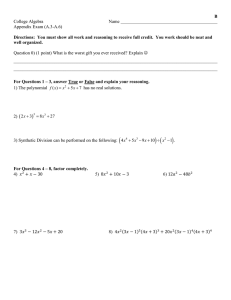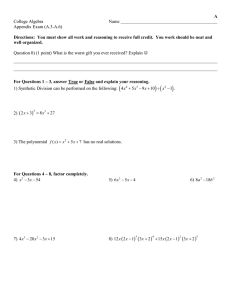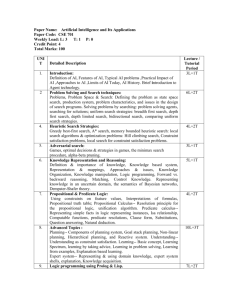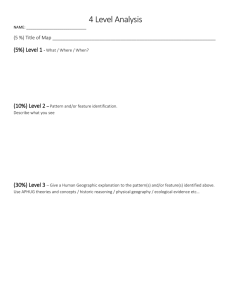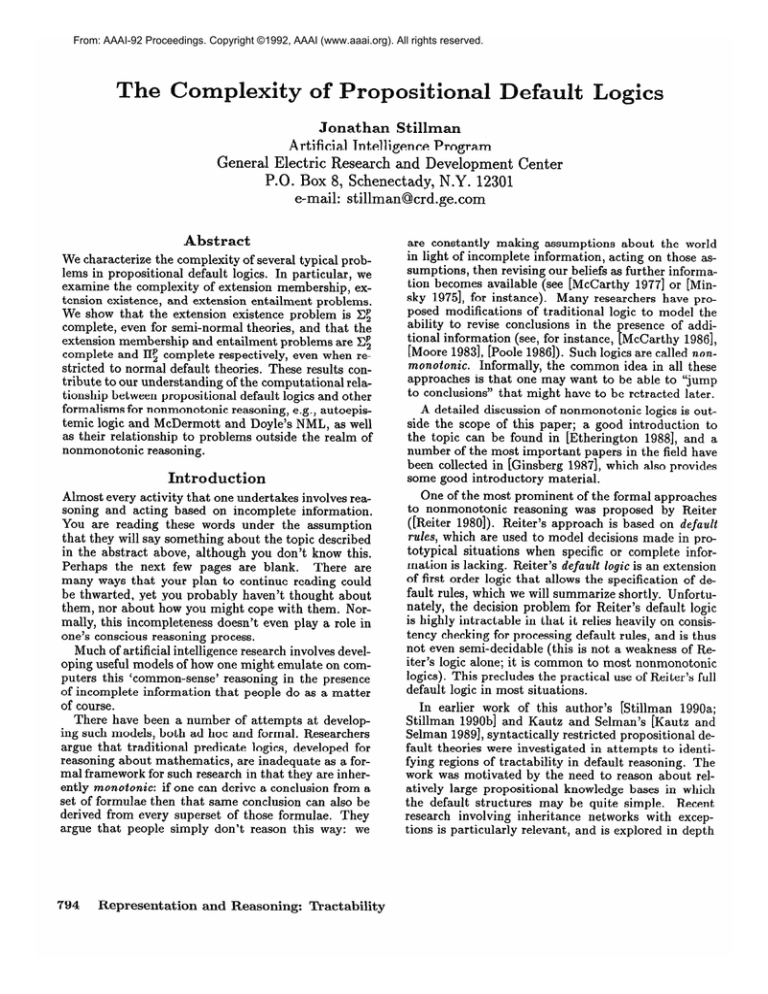
From: AAAI-92 Proceedings. Copyright ©1992, AAAI (www.aaai.org). All rights reserved.
ropositional
its
Jonathan Stillman
Artificial Intelligence Program
General Electric Research and Development Center
P.O. Box 8, Schenectady, N.Y. 12301
e-mail: stillman@crd.ge.com
Abstract
We characterize the complexity of several typical problems in propositional default logics. In particular, we
examine the complexity of extension membership, extension existence, and extension entailment problems.
We show that the extension existence problem is X;
complete, even for semi-normal theories, and that the
extension membership and entailment problems are X;
complete and II; complete respectively, even when restricted to normal default theories. These results contribute to our understanding of the computational relationship between propositional default logics and other
formalisms for nonmonotonic reasoning, e.g., autoepistemic logic and McDermott and Doyle’s NML, as well
as their relationship to problems outside the realm of
nonmonotonic reasoning.
Introduction
Almost every activity that one undertakes involves reasoning and acting based on incomplete information.
You are reading these words under the assumption
that they will say something about the topic described
in the abstract above, although you don’t know this.
Perhaps the next few pages are blank. There are
many ways that your plan to continue reading could
be thwarted, yet you probably haven’t thought about
them, nor about how you might cope with them. Normally, this incompleteness doesn’t even play a role in
one’s conscious reasoning process.
Much of artificial intelligence research involves developing useful models of how one might emulate on computers this ‘common-sense’ reasoning in the presence
of incomplete information that people do as a matter
of course.
There have been a number of attempts at developing such models, both ad hoc and formal. Researchers
argue that traditional predicate logics, developed for
reasoning about mathematics, are inadequate as a formal framework for such research in that they are inherently monotonic: if one can derive a conclusion from a
set of formulae then that same conclusion can also be
derived from every superset of those formulae. They
argue that people simply don’t reason this way: we
794
Representation
and Reasoninn:
Tractabilitv
are constantly making assumptions about the world
in light of incomplete information, acting on those assumptions, then revising our beliefs as further information becomes available (see [McCarthy 19771 or [Minsky 19751, for instance). Many researchers have proposed modifications of traditional logic to model the
ability to revise conclusions in the presence of additional information (see, for instance, [McCarthy 19861,
[Moore 19831, [Poole 19$6]). Such logics are called nonmonotonic.
Informally, the common idea in all these
approaches is that one may want to be able to “jump
to conclusions” that might have to be retracted later.
A detailed discussion of nonmonotonic logics is outside the scope of this paper; a good introduction to
the topic can be found in [Etherington 19881, and a
number of the most important papers in the field have
been collected in [Ginsberg 19871, which also provides
some good introductory material.
One of the most prominent of the formal approaches
to nonmonotonic reasoning was proposed by Reiter
([Reiter 19801). R el‘t er’s approach is based on default
rules, which are used to model decisions made in prototypical situations when specific or complete information is lacking. Reiter’s default logic is an extension
of first order logic that allows the specification of default rules, which we will summarize shortly. Unfortunately, the decision problem for Reiter’s default logic
is highly intractable in that it relies heavily on consistency checking for processing default rules, and is thus
not even semi-decidable (this is not a weakness of Reiter’s logic alone; it is common to most nonmonotonic
logics). This precludes the practical use of Reiter’s full
default logic in most situations.
In earlier work of this author’s [Stillman 1990a;
Stillman 1990b] and Kautz and Selman’s [Kautz and
Selman 19891, syntactically restricted propositional default theories were investigated in attempts to identifying regions of tractability in default reasoning. The
work was motivated by the need to reason about relatively large propositional knowledge bases in which
the default structures may be quite simple. Recent
research involving inheritance networks with exceptions is particularly relevant, and is explored in depth
in [Touretzky 19861 and in Chapter 4 of [Etherington 19881, where the close relationship between default logic and inheritance networks with exceptions
is explored. A partial order of syntactic restrictions
is described in [Kautz and Selman 19891, together
with discussion of the complexity of several problems
over this partial order when the propositional theory
is restricted to consisting of a set of literals. Their
results showed that while very simple theories may
be intractable, some syntactic restrictions result in
polynomial-time tests for determining whether certain
properties hold. In particular, they showed that one
can decide in polynomial time whether there exists an
extension that contains a given literal when the default
rules are restricted to a class they called Horn default
rules. They suggested that the ability to combine such
default theories with non-default propositional Horn
theories would be particularly useful, but left open the
question of whether the membership problem (i.e., determining whether there exists an extension of a given
default theory containing a specified literal) for such
a combination of theories is tractable. In [Stillman
199Oa], we showed that a restriction of this problem
is NP-complete, and presented several related results.
Our investigation in [Stillman 1990b) resulted in defining a richer hierarchy of default rules than that considered by Kautz and Selman, most of which result
from disallowing any prerequisites in rules. This corresponds to introducing a “context-free” element to
the reasoning, and seems to constitute the most simple type of default rule that is not completely trivial. The work described in [Stillman 1990b] considered very tight restrictions on the expressiveness of
default rules as well as the underlying propositional
theory. Unfortunately, our results showed that even
under these restrictions, membership problems almost
invariably remain intractable. These results suggested
that if practical default reasoning systems are desired,
one must either consider extremely restricted expressiveness or work to identify subcases of otherwise intractable classes that yield feasible complexity.
This paper contains the results of an examination
of the general complexity of membership, entailment,
and existence problems for arbitrary propositional default logics. Although it is clear that such problems
cannot be tractable (since they trivially contain the
tautology problem for propositional calculus), it is not
obvious exactly how hard they are. The main results
we present are that these problems are indeed higher
in the polynomial hierarchy than NP or co-NP, placing
them at the second level of the hierarchy. While the
impact of classifying a problem at the second level of
the hierarchy is not yet fully understood (similarly, we
don’t know that showing a problem to NP-complete
means that it can’t be solved efficiently, just that it’s
in the same set as a number of other problems that we
don’t know how to solve efficiently), this may indicate
that these problems are strictly harder than those in
NP (It is import
o note, however, that
and only if B =
the polynomial hiera
and only if the polynomial hierarchy collapses to P.),
although all of the problems in the polynomial hierarchy can be solved in single exponential time. From
a practical standpoint, a more complete understanding of just where the important decision problems in
propositional default logic lie in the polynomial hierarchy may help us understand how to develop better deterministic algorithms for these problems by enabling
us to exploit prior results about other problems that
lie in the same classes.
The remainder of this paper is organized as follows:
we begin with a brief description of Reiter’s default
logic, followed by a short overview of the polynomial
hierarchy. We then present the main results of this
paper, characterizing the complexity of several key decision problems for propositional default theories. Finally, we summarize and discuss related results and
future work.
Preliminaries
eiter’s Default Logic
For a detailed discussion of Reiter’s default logic the
interested reader is referred to [Reiter 19801. In this
section we will simply review some of the immediately
pertinent ideas. A default theory is a pair (D, W),
where W is a set of closed well-formed formulae (wffs)
in a first order language and D is a set of default rules.
A default rule consists of a triple < cy,,0, y >: cy is
a formula called the prerequisite, ,B is a set of formulae called the justiJications, and +yis a formula called
the conclusion.
Informally, a default rule denotes the
statement “if the prerequisite is true, and the justifications are consistent with what is believed, then one
may infer the ConcZusion.” Default rules are written
cU:p
-T-If the conclusion of a default rule occurs in the iustifications, the default rule is said to be semi-nor&al;
if the conclusion is identical to the justifications the
rule is said to be normal. A default rule is closed if it
does not have any free occurrences of variables, and a
default theory is closed if all of its rules are closed.
The maximally consistent sets that can follow from
a default theory are called extensions.
An extension
can be thought of informally as one way of “filling in
the gaps about the world.” Formally, an extension E of
a closed set of wffs T is defined as the fixed-point of an
operator F, where I’(T) is the smallest set satisfying:
e w 5 WI
e I’(T) is deductively closed,
o for each default d E D, if the prerequisite is in I’(T),
and T does not contain the negations of any of the
justifications,
then the conclusion is in I’(T).
Stillman
795
Since the operator I’ is not necessarily monotonic, a
default theory may not have any extensions. Normal
default theories do not suffer from this, however (see
[Reiter 1980]), and always have at least one extension.
In [Reiter 19801 an alternative characterization of the
extensions of a default theory is provided and proved
equivalent to that given above:
Theorem 1 (Reiter) Let E be a closed set of w$s,
and let A = (D, W) be a closed default theory. Define
l&J = w
andfori20
E i+l = Th(E$J
(
a
{E”,,II;, A; : k 2 0},
:P1,...Prn
wherz
ED
ct E Ea and +1,...7&B,E
Then E is an extension
1
of Default
xi+1
Ei
Does there exist any extension of (D, W)?
Membership Does there exist an extension of (D, W)
that contains q? (This is called goal-directed reasoning by Kautz and Selman.)
Entailment Does every extension of (D, W) contain
q? (This is closely related to skeptical reasoning,
where a literal is believed if and only if it is included
in all extensions.)
The Polynomial
Hierarchy
Complete
Problems
and CE
Representation
and Reasoning:
A:+1
= P(q).
(Note in particular that Cy = NP, and that II; =
co - NP.)
It is helpful to have a canonical complete problem
for each of these classes as a starting point in proving
completeness of new problems. This role is played be
the problem SATISFIABILITY in the theory of NPcompleteness. In [Meyer,Stockmeyer 19731, a class of
problems BI, is defined for k > 0, and it is shown that
& is complete for Ei. An instance of Bk consists of:
Input:
xl&,
A Boolean formula F over sets of variables
. . .Xk.
Question:
There exist many problems for which it is unknown
whether or not they can be solved efficiently (in time
polynomial in the length of their input). Structural
complexity theory is concerned with categorizing such
problems into equivalence classes, and with determining relationships between such classes. The most well
known class studied in structural complexity theory
is NP; hundreds of commons problems in many areas
of study have been identified as being NP-complete
or NP-hard (see [Garey and Johnson 19791 for a good
introduction to this topic). Much of the research in
structural complexity theory is directed toward providing insight into what is perhaps the most famous
problem in computer science: ‘What is the effect of
nondeterminism on computational complexity?’ This
includes the famous P = NP question.
There exist decision problems that seem to be harder
than NP-complete problems, but which we have been
796
= NP(q.),
J--G+, = co - NP(Cp,),
Theories
There are several important properties that may hold
for a default theory. Given a default theory (D, W),
perhaps together with a literal q, one might want to
determine the following about its extensions:
Existence
G = I-I; = A: = P;
and for k 1 0,
a’=0
Properties
where
I
for A ifl
E=U
unable to prove to be so. The polynomial hierarchy,
formally defined in [Stockmeyer I9761 (see also [Garey
and Johnson 19791 for an introduction) is a way of
classifying some of these NP-hard decision problems
by considering the ramifications of providing timebounded Turing machines with oracles. Thus the polynomial hierarchy is a subrecursive analog of the Kleene
arithmetical hierarchy [Rogers 19671, in which deterministic polynomial time is substituted for recursive
time, and nondeterministic polynomial time is substituted for recursively enumerable time.
The classes that comprise the polynomial hierarchy
are defined as the set
Tractability
3&,
Does
vx2,
. . .&kXk [f@=l,&, . . .xk)]
= l?
where &k is 3 if k is odd, V if k is even.
Main
esults
We are now ready to present the main results of this
paper:
Theorem 2 The Extension
propositional
default theories
Membership
Problem
is X:-complete.
for
Proof: (sketch) To show that the Extension Membership Problem (EMP) is X:-hard we reduce B2 to
EMP as follows:
Let
--
m\J(Y)Ef(x >VI
be an instance of Ba, where (x) and (Y) each denote a
set of boolean variables. The instance of EMP we will
construct has as its default theory A = (D, W) with
W = 4, and the set of default @es D is composed of
the following. For each ~i E X we introduce a new
variable ei and two default rules:
: xi A ei
Xi A ei
: -xi A ei
-Xi
A ei
Having done this, we introduce a new variable Q and
add the default rule
-elAe2A...e,.i;;,Af(X,Y):q
Q
This completes the construction. Intuitively, the new
variables ei act as enablers (the use of these variables
is not strictly necessary, but their presence aids in understanding the proof), in that they indicate that some
truth valuehas been chosen for the variable xi, and the
variable Q is used to indicate that the formula is a tautology given the choice of assignment to x.
Suppose the instance is in &, i.e., there does exist
an assignment to those variables in x --such that for
all assignments to the variables in 7, f(X, Y) = 1. To
construct an extension E that contains the literal Q,
we choose an arbitrary assignment a to the variables
in X such that f(o(y),
7) = 1. For each xi E Z, if
cx(Xi)
= 1, include in E the consequences of applying
the default rule
: xi A e;
xi
A ei
Similarly, if if f2(xi) = 0, include in E the consequences
of applying the default rule
z -Xi
A ed
1x3 Aei
Once this is done, each of the variables ei is true. Furthermore, by hypothesis, f(a(x),Y)
= 1. Thus the
default rule
--
Next we must prove that EMP is in C:.
Informally, given an arbitrary propositional default theory
A = (D, IV) we will use the iVP machine to guess the
sequence of defaults to be applied in constructing an
extension E that contains q, then use the NP oracle to
verify that the chosen defaults are applicable, that no
other default rules can be applied (E is an extension),
and that Q E E. (It should be noted that we do not
need to actually create the extension; it suffices to augment W with the consequences of the chosen default
rules, and verify that (a) no other default rules can
be applied, and (b) th e set of propositional sentences
thus created is consistent. The actual size of the extension may be exponential in the size of the original
presentation since it contains the logical closure of a
set of propositional sentences, and thus we cannot afford to express it explicitly.) It is also important to
the correctness of the proof that each default rule will
be chosen at most once in deriving an extension, thus
guaranteeing that the guess provided by the oracle is
polynomial in length with respect to the instance. This
follows from the lemma below:
Lemrraa 3 Let E be any extension of a propositional
default theory A = (D, W), with IDi = n. Then, using
the description
of extensions presented in Theorem 1,
E = U;., Ei, i.e., at most n steps are needed to
produce the extension.
Proof of the lemma is straightforward and omitted.
More formally, we can appl the following theorem,
from [Meyer,Stockmeyer 1973si. (The theorem applies
to Zi for arbitrary Ic. We have specialized it to the
case where k: = 2 for simplicity.)
Theorem 4 (Stockmeyer-Meyer)
Let 0 be a finite
alphabet and A c @+.A E Zt i$ there is a polynomial
p(n), an alphabet I’, and a ternary relation R E P such
that for all x E O+,
elAe;!A...e,Af(X,Y):q
Q
is applicable, allowing us to include Q in E. It is easy
to see that the result of applying the specified defaults
produces an extension that contains 4.
Conversely, if there exists an extension E containing
4, we maintain that the instance of B2 is satisfiable.
The only way that q can be included in E is if the
default rule
-el Ae2 A...e,
A$ X,Y)
:q
Q
has been applied. Thus each of the ei variables is also
in E, sign+ing that for each xi either xc or lxi is in
E, and f(X, Y) is provable in E. Since E can impose
no restrictions on Y, this signifies that once the choice
of a truth value for each x8: via application of default
rules has been madeLit is--the case that for all values
of the variables in Y, f(X, Y) is true. It is now a
trivial matter to construct a satisfying assignment for
the instance of B2.
x E A
iff
$Nz
R(x,y,z)
where y, x range over all words in I’+
exceeding P(lXI)-
of length
not
Applying this theorem is somewhat involved and is
omitted. •I
Several related
straightforwardly:
theorems
Theorem 5 The Extension
propositional
default theories
and
corollaries
follow
Entailment
Problem
is II:-complete.
for
Corollary 6 The Extension
normal
propositional
Membership
Problem for
default theories is C;-complete.
Corollary 7 The Extension
normal
propositional
Entailment
Problem for
default theories is @-complete.
Although it is known [Reiter 1980; Etherington 19881
that the extension existence problem is trivial for normal default theories, the next theorem demonstrates
that relaxing this assumption introduces intractability.
Specifically, we show that
Stillman
797
Theorem 8 The
propositional
Extension
default theories
Existence
Problem
is C;-complete.
for
Proof: (sketch) The construction is similar to that
provided in the proof of Theorem 2 above, with the
following default rules added:
:qA-a
Q
:aAyc
a
’
>
Arguments similar to those given in the proof of Theorem 2 above demonstrate that if the instance of B2
is true then there is a derivation that proceeds as in
Theorem 2 that concludes Q by applying the default
rule
Ael Ae2 A...e,F,
Af(X,Y):
q
within that paradigm. An extended version of this paper describes our results in this area. Similar results
have been derived independently by Georg Gottlob
[Gottlob 19921 recently; he has looked at default logics,
NML, autoepistemic logic, and the closely related logic
N, defined in [Marek and Truszczynski 19901. Rutenberg [Rutenberg 19911 has derived related results for
ATMS [deKleer 19861. Researchers have just begun to
classify the structural complexity of these problems.
The characterization we have established thus far will
serve as an aid in understanding the relationships that
exist between various formalizations of nonmonotonic
reasoning and in understanding the computational relationships that exist between nonmonotonic reasoning
and other problems in computer science.
Q
This may not be an extension, however, in that one can
add a to the extension by applying the second default
rule above. One can verify that this is an extension.
If the inst ante of B2 is false, however, then the literals in the set {q, a, b} can only be included by applying the default rules above (the key observation here
is that there is no other support for Q, nor for la).
One can verify that these three rules are circular, thus
there does not exist any extension. This shows that
the Estension Existence Problem is Cg-hard.
Demonstrating inclusion in Cs is quite similar to
Theorem 2, and is omitted here for the sake of brevity.
cl
We have the following:
Corollary 9 The
semi-normal
complete.
Extension
Existence
Problem
propositional
default theories
is
for
C;-
Conclusions
In this paper, we have characterized the complexity of several fundamental problems in propositional
default logics, showing that even restricted versions
of the extension existence problem are C; complete,
and that such restrictions of the extension membership and entailment problems are C: complete and Hg
complete respectively, This work, taken to ether with
that presented in [Kautz and Selman 1989!I and [Stillman 1990b], provides an extensive categorization of the
complexity of propositional default logics.
One of the most interesting areas for further research is in understanding the ramifications of these
results on known formalisms for nonmonotonic reasoning. The results described above can be reproduced
for the closely related questions of derivability, arguability, and fixed-point existence within propositional
NML[McDermott and Doyle 19801. This strengthens results presented in [Niemela 19891, who showed
membership, but left open questions of completeness.
Furthermore, given the efficient intertranslatability between the extensions of propositional default lo& and
strongly grounded extensions in autoepistem‘Ilc logic
[Konolige 19881, similar results can be shown to hold
798
Representation
and Reasoning:
Tractability
Acknowledgements
The author is indebted to Dan Rosenkrantz for helpful
discussions concerning this work, and to the referees
for several insightful comments.
References
de Kleer, J., 1986. An Assumption-Based Truth29:241Maintenance System. Artificial Intelligence,
288.
Etherington, D.W. 1987. Formalizing Non-Monotonic
Reasoning Systems. Artificial Intelligence 31:41-85.
Etherington, D.W. 1988. Reasoning with Incomplete
Information.
Pitman, London.
Garey, M.R., and Johnson, D.S. 1979. Computers and
W.H. Freeman, New York.
Intractability.
Ginsberg, M.L., editor. 1987. Readings in Nonmonotonic Reasoning.
Morgan Kaufman, Los Altos, CA,
1987.
Gottlob, Georg 1992. Complexity Results for Nonmonotonic Logics. Presented at the Fourth International Workshop on Nonmonotonic Reasoning, May
1992.
Kautz, H.A., and Selman, B. 1989. Hard problems
for simple default logics. In Proceedings of the First
International Conference on Principles of Knowledge
Representation and Reasoning, 189-197, Toronto, Ontario, Canada.
Konolige, K., 1988. On the Relation between Default
and Autoepistemic Logic. Artificial Intelligence, 35.
Marek, ‘Mr., and Truszczynski, M., 1990. Modal logic
for default reasoning. Annals of Mathematics and Artificial Intelligence,
1~275-302.
McCarthy, J. 1977. Epistemological problems of artificial intelligence. In Proceedings of the Fifth International Joint Conference on Artificial Intelligence,
1038-1044. International Joint Conferences on Artificial Intelligence, Inc.
McCarthy, J. 1986. Applications of circumscription
to formalizing commonsense knowledge. Artificial Intelligence, 28:89-166.
McDermott, D., and Doyle, J. 1980. Non-monotonic
logic I. Artificial Intelligence,
13:41-72.
A framework for representing
Minsky, M. 1975.
knowledge.
In Patrick Winston, editor, The Psychology of Computer Vision, pages 211-277. McGrawHill, New York.
Semantical considerations on
Moore, R.C. 1983.
nonmonotonic logic. In Proceedings of the Eighth
International Joint Conference on Artificial Intelligence, 272-279, Karlsruhe, West Germany, International Joint Conferences on Artificial Intelligence, Inc.
Niemela, I. 1989. On the complexity of the decision
problem in propositional nonmonotonic logic. In Proceedings of the 2nd Workshop on Computer Science
Logic, Duisburg, FRG, Oct. 1988, Springer-Verlag
LNCS Volume 385.
Poole, D.L. 1986. Default reasoning and diagnosis as
theory formation. Technical Report CS-86-08, Dept.
of Computer Science, University of Waterloo.
Reiter, R. 1980. A logic for default reasoning. Artificial Intelligence,
13:81-132.
Rogers, H. 1967. Theory
of Recursive
Functions
and
MIT Press, Cambridge.
Rutenberg, V., 1991. Complexity Classification in
In Proceedings of
Truth Maintenance Systems.
STACS 91, Springer-Verlag LNCS 240.
Eflective
Computability.
Stillman, J.P. 1990a. The Complexity of Horn Theories with Normal Unary Defaults. In Proceedings
of the 8th Canadian Artificial Intelligence Conference, (CSCSI/SCEIO-90),
Ottawa, Canada, 23-25
May, 1990, published by Morgan-Kaufman Publishers
(also available as a General Electric Research and Development Center Technical Report, #89CRD243).
Stillman, J.P. 1990b. It’s Not My Default: The Complexity of Membership Problems in Restricted Propositional Default Logics. In Proceedings of the 8th
National Conference on Artificial Intelligence (AAAI90), 29 July - 3 August 1990, AAAI Press/ MIT Press,
Menlo Park.
Stockmeyer, L. 1976. “The polynomial-time
chy,” Theoretical Computer Science 3, l-22.
hierar-
Stockmeyer, L., and Meyer,A., 1973. Word problems
requiring exponential time: preliminary report. In
Proceedings of the Sixth IEEE Symposium on Switching and Automata Theory l-9.
Touretzky, D.S. 1986. The Mathematics
tance Systems. Pitman, London.
of Inheri-
St illman
799

